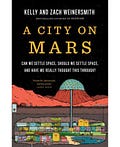Are you one of these people who fantasise of space-age utopias, where humans roam the red plains of Mars in futuristic bubbles, while enjoying their morning coffee in the Martian sunrise. Or perhaps you’re grounded, skeptical, and not completely convinced by the tweets of Elon Musk, and you prefer to have your morning coffee in your neighbourhood café. Whichever camp you fall into, A City on Mars challenge you to ponder what it would take to bring humanity to Mars and whether we’re ready—or even willing—to make that leap.
The authors of this intelligent, well-researched and witty book, the Weinersmiths —Kelly, a scientist, and Zach, best known for his work in webcomics—make it clear that the journey to Mars is not as simple as packing your bags and buying a ticket. Space, while awesome, is also a harsh environment, filled with radiation, low in gravity, which significantly impacts bones by reducing their density and mass, and hostile to human biology. Could humans truly survive, let alone thrive, in such an inhospitable world?
Babies on Mars
Starting with the basics, the authors delve into the biological hurdles of colonizing Mars. Even Mars will need moms, dads, and babies. The question therefore is, can we have babies in space? The simple answer is, we don’t know. Can women even get pregnant — let alone stay pregnant — in space? Again, we don’t know. As of now, there is no confirmation of humans even having engaged in sexual activity in space, although it seems likely that sex in space has already happened. NASA maintains that astronauts have not had sex during missions, emphasizing that the environment aboard spacecraft is highly professional and focused on scientific tasks.
The Weinersmiths picture artificial wombs spinning in gravity-simulation centrifuges and nurseries shielded from cosmic rays, all extremely exciting and very Star Trek like, which make living in space pretty awesome. These sci-fi ideas illustrate the vast gap between fiction and the rigorous science needed to sustain human life off Earth. When on Mars, you won’t be able to zoom across the galaxy to leave the toddler to the grandparents so that you can enjoy a romantic weekend or to produce a holographic playground that it can keep your little one happy, engaged and safe for a couple of hours so to be able to finish that novel that has been sitting in your bedtable for ages.
Living on Mars: Where ‘Good Enough’ Isn’t Good Enough for Survival
Beyond the biological challenges, there’s also the question of daily survival. Survival isn’t just about oxygen. Life-support systems for a Martian colony would need to be flawlessly engineered to withstand extreme conditions. On Mars there are no second chances, you can’t just hop in the car or take the train to another colony. Small failures could quickly escalate to life-threatening crises. Take Biosphere 2, for example, a self-contained ecosystem created in Arizona in the 1990s that served as a prototype for Mars habitats. After a year, the oxygen had dwindled to dangerously low levels, and the farm was not producing enough crops. As a result, the crew were both suffocating and starving. In the end members of Space Biosphere Ventures’ management team pumped oxygen into the building and used a CO2 “scrubber” without disclosing their actions publicly. Far from a flawless experiment, Biosphere 2 remains a harsh reminder of the difficulty of maintaining a closed ecosystem.
Bear in mind that in a space habitat might not be a management team to pump oxygen to your biosphere. The lesson? If you are planning to go to Mars, make sure the life-support systems are intricately designed and endlessly reliable.
Who Owns Mars? The Uncertain Future of Martian Governance
Even if we solve the technical challenges, there’s the thorny issue of who gets to rule Mars. Today’s space law—based on the Cold War-era Outer Space Treaty—prohibits territorial claims but doesn’t regulate resource extraction. The authors argue that this law may hold only until something genuinely valuable is found on Moon or Mars. In today’s era of billionaire-powered space races, an outdated space law could turn space from the Final Frontier to a 21st-century 'Wild West', where corporations will battle for control over critical resources, and the transport of wealthy tourists, miners, and settlers. Given the scarcity of livable areas on Mars or the Moon there is the possibility of “land grabs” with nations or corporations to race to claim Martian soil before we have clear governance in place.
A Backup Plan for Humanity?
A prevailing argument for Mars colonisation is the “backup plan”—the idea that Mars could serve as a refuge if Earth becomes uninhabitable. However, the Weinersmiths systematically dismantle this notion, showing that the cost and the resources required to create a viable, self-sustaining colony on Mars would dwarf those needed to protect our home planet. After all, Mars is a barren, irradiated wasteland, while Earth, despite its serious issues, remains profoundly a more hospitable option.
In any case, they convinced me that a city on Mars is not coming anytime soon, at least not within my lifetime - unless there is substantial progress in life extension technology, for which I am still hopeful.
In the end, A City on Mars leaves us with a powerful message: perhaps our best hope lies not in escaping Earth but protecting what we already have- before it’s too late. Unless we’ve somehow really, really, screwed up, even on its worst day, even if climate change goes as bad as it could possibly go, Earth is, and it will be for a long time still a pretty great place to call home. A home —where the morning coffee, thankfully, requires no space suit.



